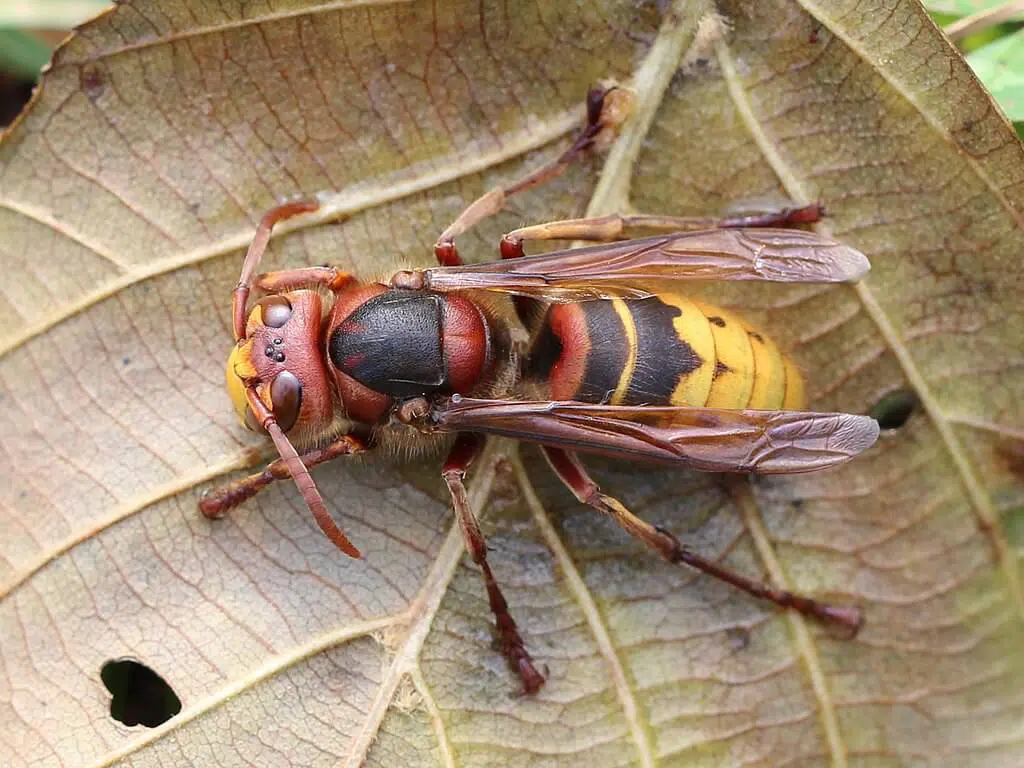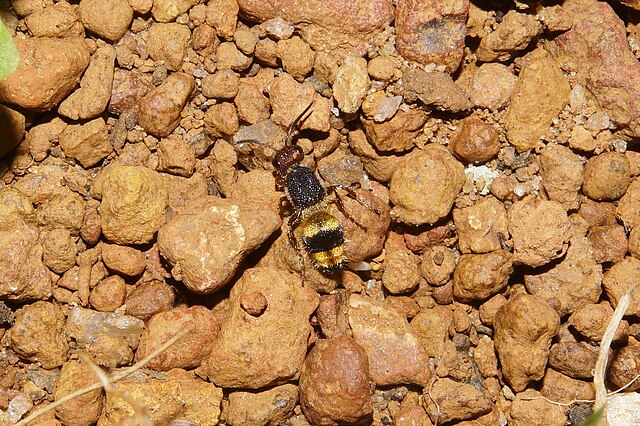While most wasps are diurnal there are numerous species of nocturnal wasps. Some species show active behavior both during the day and during the night. Most nocturnal wasps have ocelli adaptations that allow them to see in the dark.
Many types of wasps that are nocturnal are attracted to lights. Closing the windows when the light is on is recommended for homeowners who fear wasps. Other nocturnal wasps are solely interested in finding spiders or other types of food at night.
Nocturnal wasps rarely rest during the day as well. They tend to care for their nests during the day. Repairs are made to the nest when needed by nocturnal wasps during the day.
These types of wasps that are active during the night also care for their larva and eggs during the day. Some species of nocturnal wasps are seen blocking the entrance to their nest by grouping themselves against predators, rarely getting a chance to rest.
Table of Contents
1. Are Wasps Active At Night?
Most wasps are diurnal. This means they are active during the day when they build nests, feed larva, and seek out food during the day.
A smaller percentage of wasps are active during the night as well. These wasps are known for going out after food which is easy to find at night such as certain insects. As an example, wasps that hunt nocturnal spiders go out during the night.
Species of nocturnal wasps can fly at night. They can go on in search of nocturnal caterpillars, mainly for laying eggs on them. Other wasps that go out during the night do so mainly in search of food.
Moths, spiders, and fruit-eating insects are some of their preferred nighttime prey.
2. Nocturnal Wasps
The following species are known for their nocturnal nature. Many of them are common in the US and North America while others are found in different areas of the world.
#1. Nocturnal Paper Wasps

The Nocturnal Paper Wasp (genus Apoica) is one of the species that are highly active during the night. The species is mostly known for its nocturnal food-seeking activities. These foraging nocturnal activities aren’t backed by inactivity during the day.
The wasps actively cool the nest by spreading their wings as much as possible to block off direct sunlight which is detrimental to proper larva formation.
Nocturnal Apoica wasps don’t rest much during the day either. These wasps are all seen gathered at the nest entrance shielding it from intruder species. These wasps protect the eggs from other diurnal insects and predators by sealing off the nest entrance with their bodies.
#2. European Hornets

The European Honert (Vespa Crabro) is the most common nocturnal wasp in the USA. It looks for food and it can sting people even at night. This common wasp species has also been shown to be attracted by lights. This is why it often makes its way indoors at night.
Removing European Hornets at night is almost impossible as they’re active. Most of these wasps are only found back in the nest just before sunrise. Otherwise, they roam around all night.
Some of these wasps bang against closed windows as they’re attracted by light sources constantly.
#3. Night Hornets

Night Hornets (genus Provespa) are nocturnal wasps. They are the only nocturnal wasp of the Vespa family. Benefiting from long wings, these wasps easily fly at night. The queen works together with a swarm to build complex nests during the night.
#4. Ichneumonid Wasps

These wasps have 2 large eyes and 3 large ocelli that help them see at night. They are frequently seen around homes in suburban areas during the night as they’re attracted by light. However, they live further out in fields where they can lay eggs underground or directly on their prey.
#5. Braconid Wasps

These wasps are parasitic. They kill their host. In the case of Braconid Wasp, the hosts are caterpillars. The wasp lays eggs on top of caterpillars so they have a source of food once they emerge. These wasps roam at night seeking caterpillars which are often devouring crops.
#6. Velvet Ants

Velvet Ants from the family of Mutillidae are sometimes nocturnal. Some of these species of the family only come out at night. Exceptions apply to females that can also be diurnal or come out during the day.
These wasps only sting defensively. However, their sting is painful. The stinger of Velvet Ants is long, around half the length of its body. Some nocturnal Velvet Ants can painfully sting.
#7. Brachycistidinae Wasps

This wasp species is known for a dual taxonomy when the male looks and lives differently from the female. The male Brachycistidinae Wasps is nocturnal while the female is diurnal.
The male also has wings while the female has no wings, mainly resembling ants. Male wasps are attracted by light while flying during the night. Females live underground during the night.
#8. Meteorinae Wasps

This family of wasps (subfamily Meteorinae) comprises multiple sub-species. Some of them are nocturnal, but only as adults. Young wasps of the species don’t fly at night. This parasitic species is also present in the US. Meteours is a Neteorinae wasp found in the country.
3. What Do Wasps Do At Night?
Nocturnal wasps are as active as diurnal wasps. They do the exact things a diurnal wasp does. This involves looking for food, laying eggs, building and repairing nests. These activities are not limited in any sense due to their nocturnal nature.
Nocturnal Wasps Are Active During The Night
This means that they aren’t found in their nests or underground (in the case of digging wasps). These wasps go out looking for food such as moths, pollen, or other insects. Nocturnal wasps see during the night but they can also fly towards light sources.
Some species of wasps that only eat and hunt nocturnal prey aren’t categorized as nocturnal as they mostly sit in clusters during the night, together with other wasps. The Blue Mud Wasp kills Black Widow Spiders (that are mostly nocturnal) at night. It prefers to be active during the day.
Diurnal Wasps Don’t Fly At Night
However, they don’t sleep either. These wasps typically carry out duties around the nest at night. For instance, they can care for larvae which is a constant effort that is sometimes multiannual.
These wasps can also repair the nest where needed at night. Fibers that are already in the nest are used to repair it. Some parts of the broken nest that don’t require collecting other plant fiber can also be fixed at night.
These activities are not hidden or hard to see. Repairing the nest is often an activity that creates a lot of noise. This noise can be heard from a few feet away at night.
4. Do Wasps See At Night?
Nocturnal wasps can see at night. Ocelli are a type of visual organ wasps have on top of their heads. Nocturnal wasps have ocelli adaptations that allow them to see at night.
The ability to see in the dark allows these wasps to be as efficient as diurnal wasps.
5. Wasps Can Make Noise At Night
Wasps make a lot of noise at night, mainly because they don’t sleep like humans. Wasps tend to be active during the night, even when they aren’t nocturnal in their nest.
The larva makes noise and wasps repairing the nest also make noise at night. Nocturnal wasps make noise at night while flying.
6. Is It Best To Kill Wasp Nest At Night?
The common assumption is that wasps aren’t as dangerous or they can’t sting at night. This is what leads some people to believe wasp nests can be removed at night.
As seen above, there are many types of nocturnal wasps. Some of them can even see in the dark. This means they can sting if they feel the nest is threatened.
7. How To Remove Wasp Nests at Night?

There are a few methods of removing wasps nests at night that are safer than others. Burning the wasp nest or flooding is not recommended.
Burning a wasp nest made out of paper-like materials that are highly flammable comes with its own set of dangers.
Flooding the nest with water can damage your home if the nest is close to a wall.
Call a contractor
The safest way to remove a wasp nest is to hire a professional. Protective tools and suits as those used for bees are required when removing a nest. Hitting the nest with a bat or flooding it with water aren’t viable methods for homeowners.
Remove the nest with a garbage bag
Removing the nest entirely without allowing wasps to escape is a proven method. You need to approach the nest quietly and place the bag over it completely.
Once the garbage bag covers the nest it can be removed from the tree branch, wall, or ceiling. The garbage bag then needs to be sealed completely and placed in the garbage disposal.